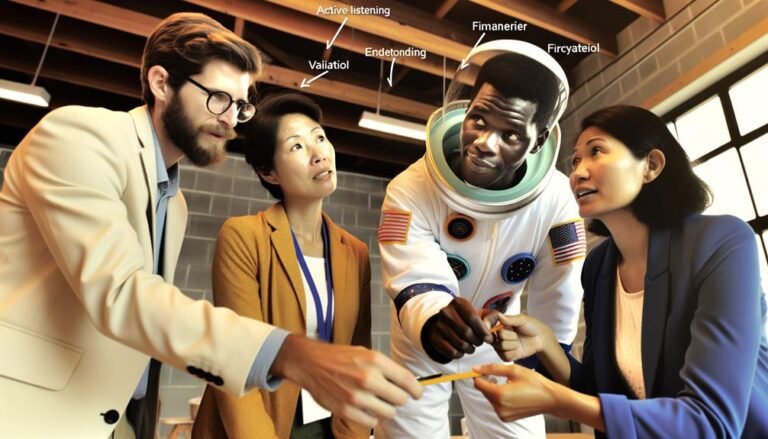What Is Learning and Development?
Within the realm of organizational development, Learning and Development (L&D) stands as a fundamental pillar for nurturing employee skills and enhancing organizational performance.
But what exactly constitutes this multifaceted domain? Understanding the intricacies of L&D involves delving into its core principles, methodologies, and impact on modern workplaces.
As organizations navigate the evolving landscape of talent development, the question of what truly defines Learning and Development becomes increasingly pertinent.
Key Takeaways
- Learning and Development is vital for enhancing employee capabilities and driving business performance.
- L&D professionals need a mix of personal, professional, and organizational skills for success.
- Developing an L&D strategy involves aligning with business goals and promoting lifelong learning.
- Various roles in L&D, such as trainers, instructional designers, and managers, contribute to skill development.
Importance of Learning and Development
Learning and Development is a cornerstone in fostering continuous growth and enhancing organizational performance through strategic talent development initiatives. Employee Engagement and Performance Improvement are key outcomes of investing in L&D.
By offering Continuous Learning opportunities and Career Development paths, organizations can boost employee morale, productivity, and loyalty. Engaged employees are more likely to contribute effectively to business objectives, leading to improved overall performance.
L&D programs play a crucial role in upskilling employees, preparing them for future challenges, and retaining top talent. In today's competitive landscape, prioritizing Learning and Development is essential for organizations looking to stay agile, innovative, and ahead of the curve.
Key Components of L&D
Amidst the strategic focus on fostering continuous growth and enhancing organizational performance through talent development initiatives, understanding the key components of Learning and Development is paramount for aligning workforce capabilities with business objectives.
Training methodologies form a fundamental component of L&D, encompassing diverse approaches such as instructor-led training, e-learning, simulations, and on-the-job training. These methodologies cater to different learning preferences and ensure effective knowledge transfer.
Additionally, employee engagement is a critical element in L&D, involving strategies to motivate and involve employees in the learning process. By fostering a culture of continuous learning and providing opportunities for skill development, organizations can enhance employee engagement levels, leading to improved performance and retention rates.
Skills Needed in L&D
In the realm of Learning and Development, proficiency in a diverse set of skills is essential for professionals to effectively drive talent development initiatives and align organizational objectives with employee growth. L&D professionals need to possess skills in personalized training, facilitating professional development opportunities, and leveraging technology for efficient learning delivery. Below is a table highlighting the key skills required in the field:
| Skills | Description | Importance |
|---|---|---|
| Personalized Training | Tailoring learning experiences to individual needs | Enhances engagement |
| Professional Development | Designing career growth programs | Fosters employee retention |
| Technological Proficiency | Utilizing digital tools for effective training | Enhances learning outcomes |
| Communication Skills | Conveying information clearly and effectively | Facilitates knowledge transfer |
Developing an L&D Strategy
Crafting a robust Learning and Development (L&D) strategy demands meticulous alignment with organizational objectives and a keen focus on enhancing workforce capabilities. Strategic alignment ensures that L&D initiatives directly contribute to business goals, while performance enhancement aims to uplift employee skills and productivity.
Conducting a thorough gap analysis helps identify areas where training and development can address skill deficiencies. Moreover, fostering employee engagement is crucial for the success of any L&D strategy, as motivated employees are more likely to participate actively in learning initiatives.
Roles in L&D Field
Fostering a successful Learning and Development (L&D) strategy necessitates a clear understanding of the diverse roles within the field that contribute to enhancing employee skills and organizational performance.
Training specialists play a crucial role in designing and delivering effective training programs tailored to meet specific learning needs. They ensure that employees acquire the necessary skills to excel in their roles.
Career development is another vital aspect, where professionals assist employees in setting career goals, identifying development opportunities, and planning for advancement within the organization.
These roles work hand in hand to create a supportive learning environment that fosters continuous growth and development, benefiting both the employees and the organization as a whole.
Emerging Trends in L&D
The evolution of learning and development practices in the modern workplace reflects a dynamic landscape driven by technological innovation and the demand for personalized employee growth experiences.
- Personalized Learning: Tailoring learning experiences to individual employee needs enhances engagement and knowledge retention.
- Upskilling Initiatives: Investing in upskilling programs ensures that employees have the necessary skills for future roles and responsibilities.
- Adaptive Learning Platforms: Utilizing technology to provide adaptive learning paths based on individual progress and preferences.
- Microlearning: Delivering content in small, bite-sized modules allows for quick consumption and immediate application in the workplace.
These emerging trends in L&D aim to create more effective and efficient learning experiences, ultimately leading to a skilled and adaptable workforce.
Technology in Learning
Incorporating technological advancements in learning methodologies revolutionizes the delivery and effectiveness of employee training programs. Virtual reality training and AI learning platforms provide immersive and interactive experiences, enhancing knowledge retention and engagement.
Gamification in education leverages game elements to make learning fun and motivating. Digital learning tools enable personalized learning pathways, catering to individual needs and learning styles.
These technologies offer flexibility in accessing training materials anytime, anywhere, promoting continuous learning. By embracing these innovations, organizations can create dynamic and impactful learning experiences that align with the evolving needs of the workforce.
The integration of technology in learning not only enhances training outcomes but also ensures that employees are equipped with the skills required to succeed in a rapidly changing work environment.
Future of L&D
What emerging trends are shaping the future landscape of Learning and Development (L&D) initiatives within organizations?
- Personalized learning: Tailoring learning experiences to individual employee needs and preferences enhances engagement and knowledge retention.
- Data analytics: Leveraging data to measure the effectiveness of L&D programs, identify trends, and make informed decisions for continuous improvement.
- Technology integration: Advancements in technology will continue to revolutionize how learning is delivered, making it more accessible and interactive.
- Focus on future skills: L&D will increasingly prioritize developing skills that align with the evolving needs of the workforce, preparing employees for the jobs of tomorrow.
Conclusion
In conclusion, Learning and Development plays a crucial role in organizational growth and employee success. By focusing on key components, developing relevant skills, and implementing effective strategies, L&D professionals can drive innovation and foster a culture of continuous learning.
As technology continues to shape the future of L&D, organizations must adapt to stay ahead of the curve. The future of L&D holds promising opportunities for personalized learning experiences and upskilling the workforce for sustained success in the competitive business landscape.






